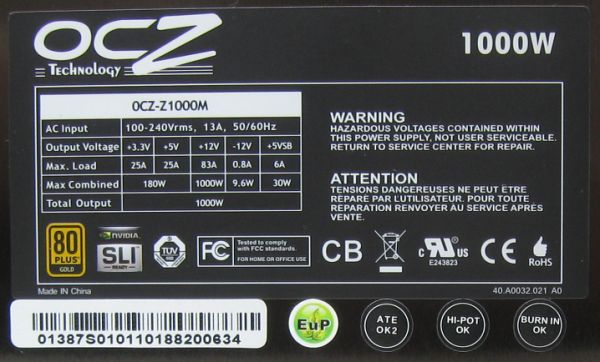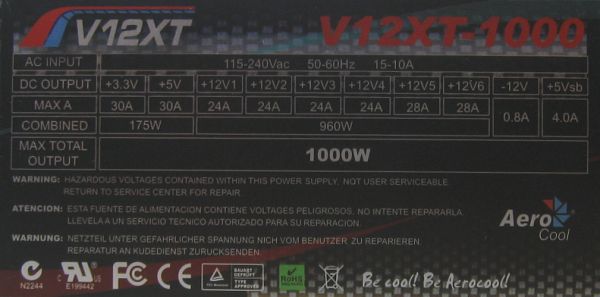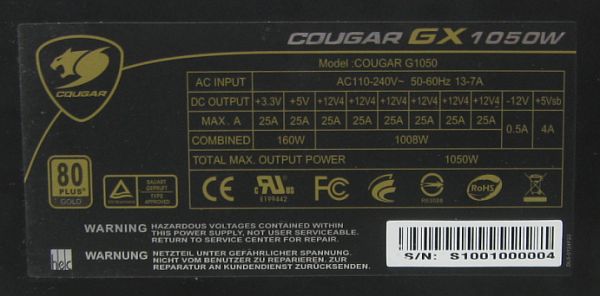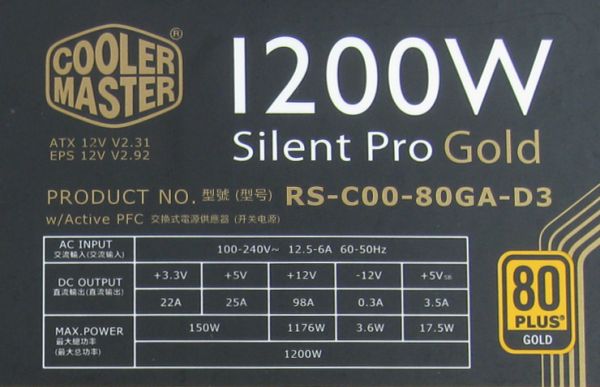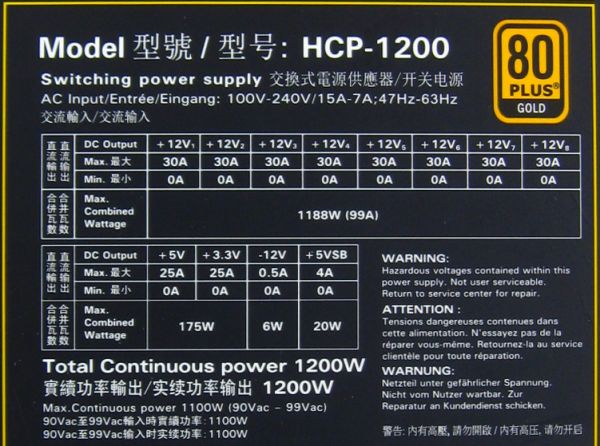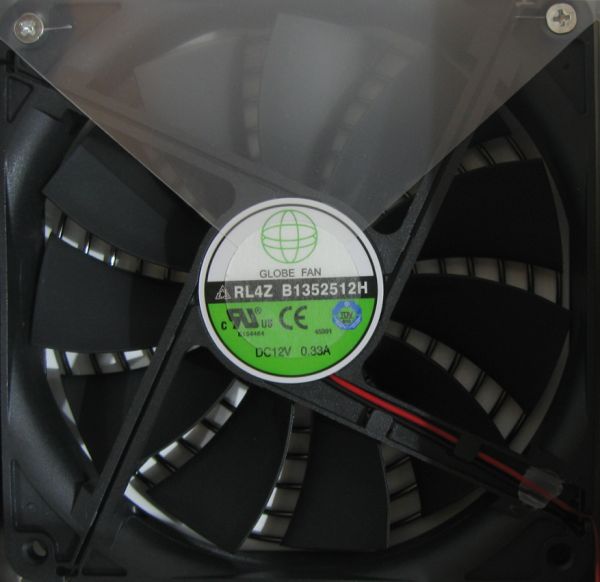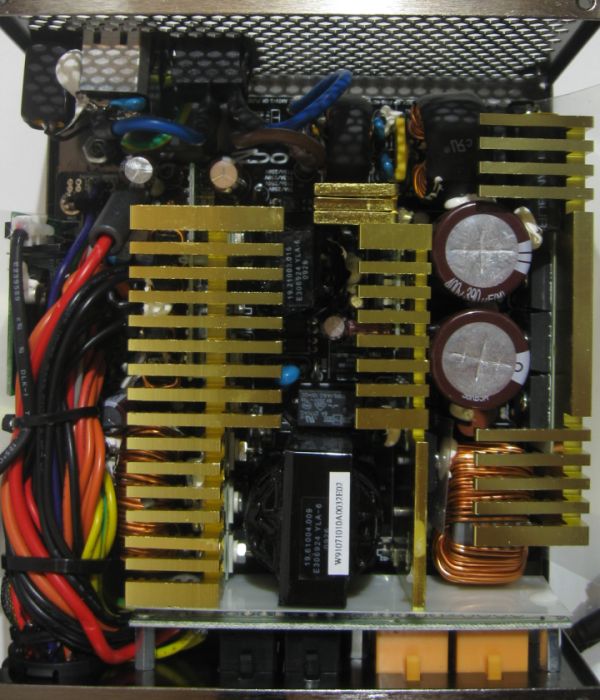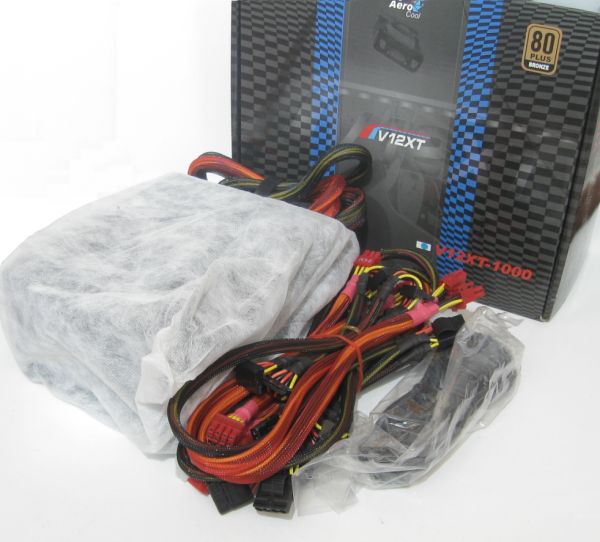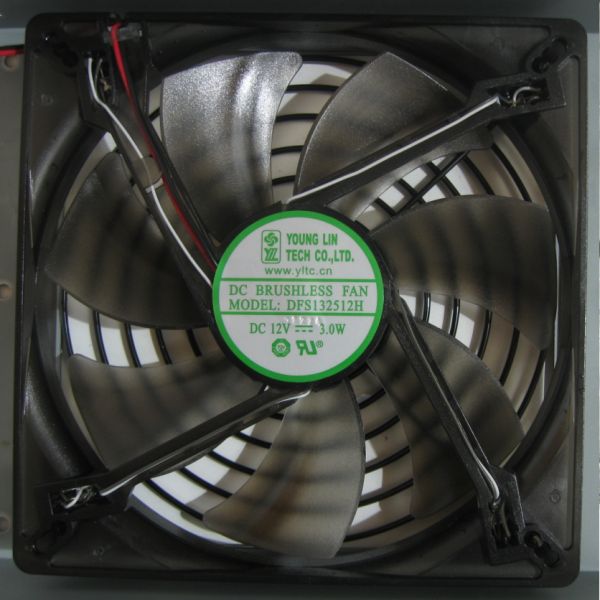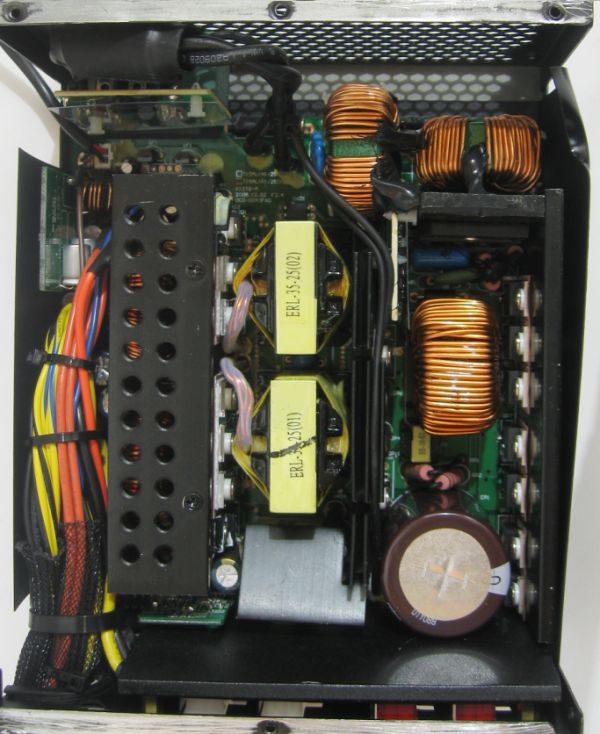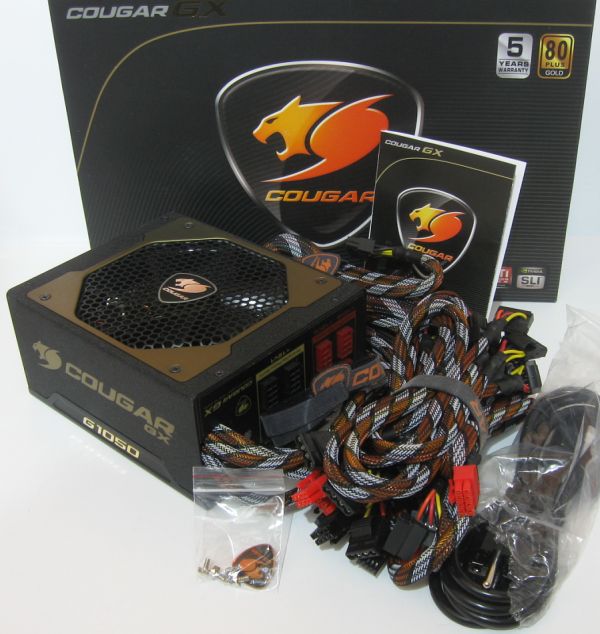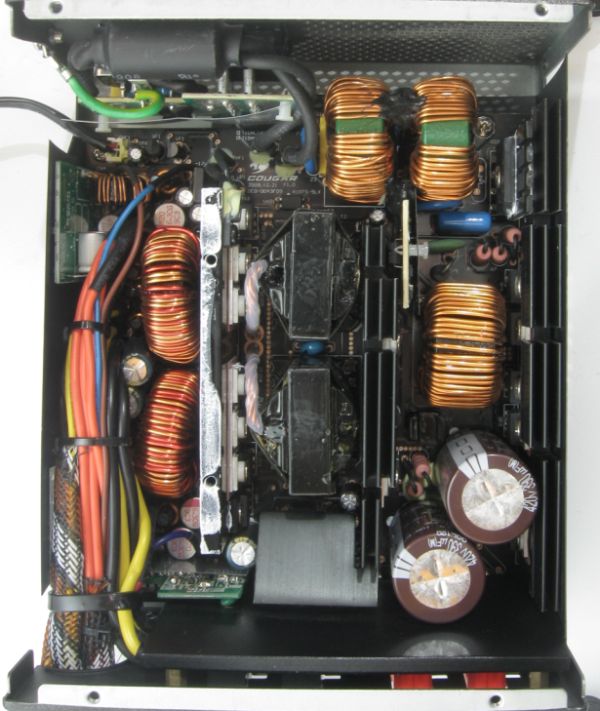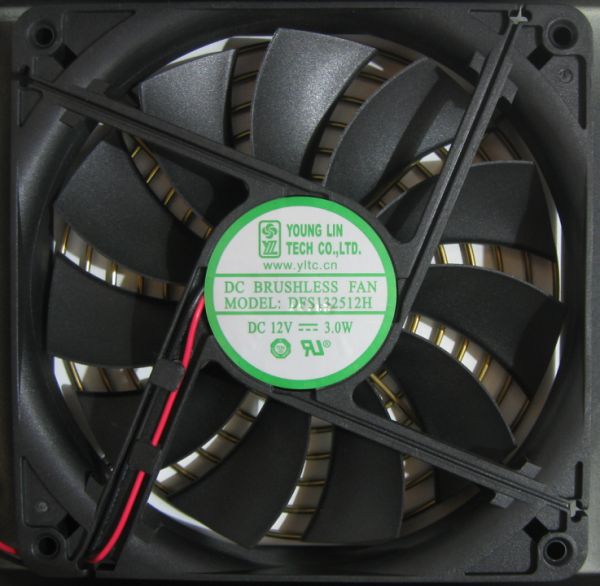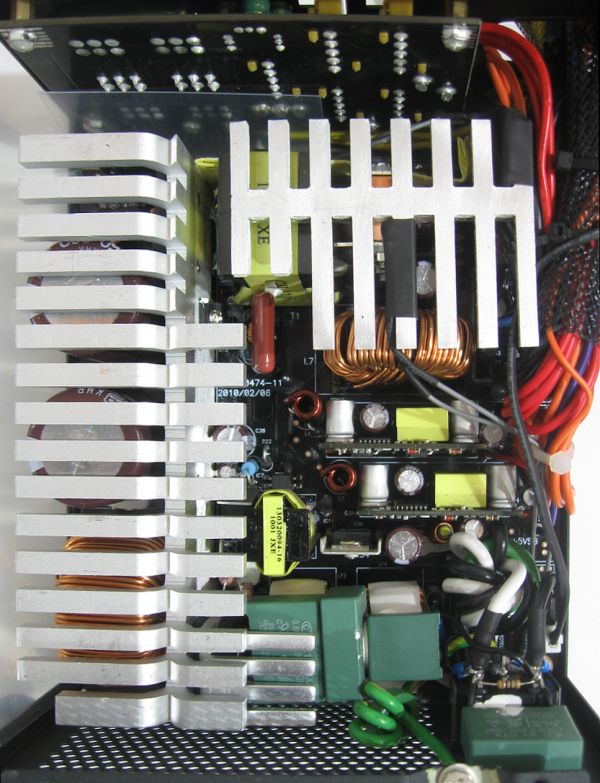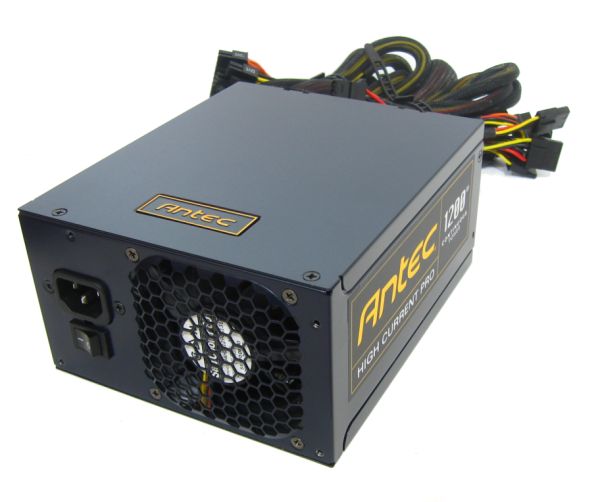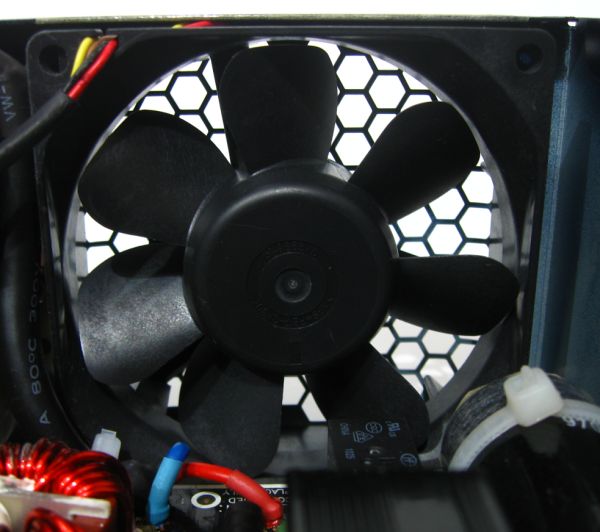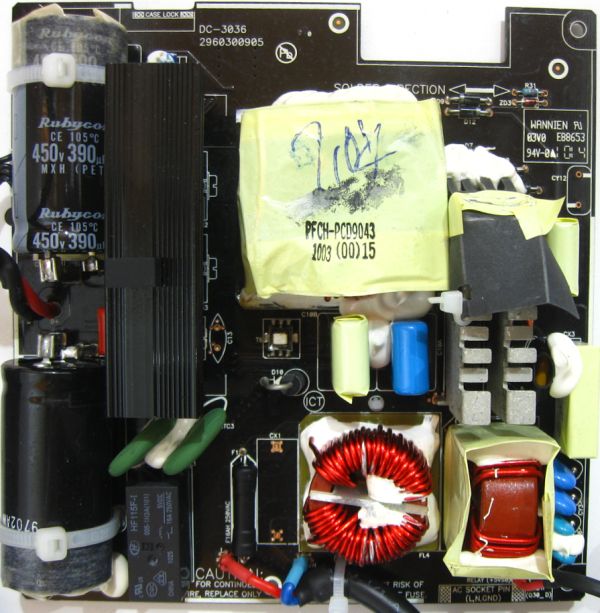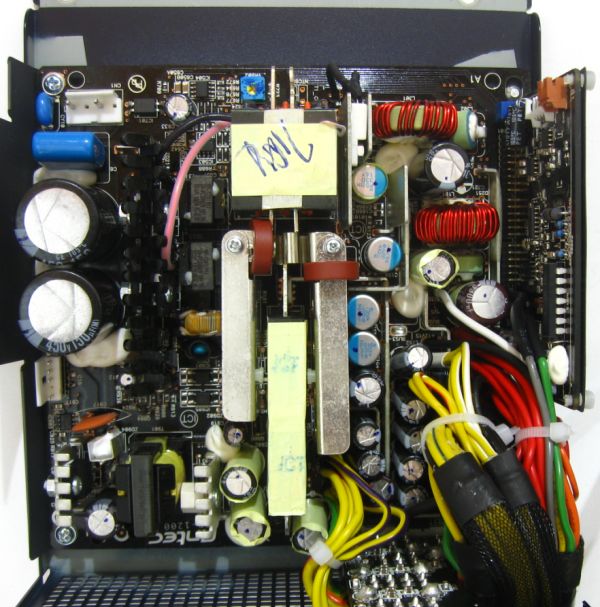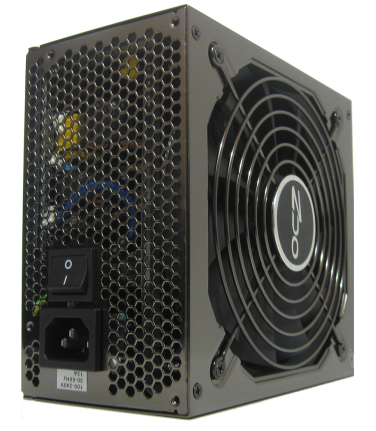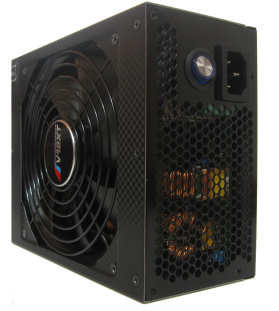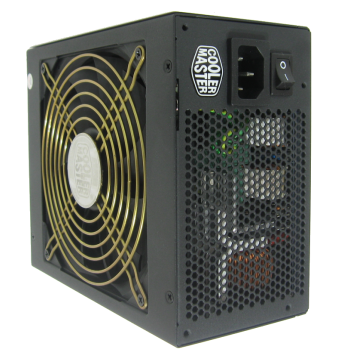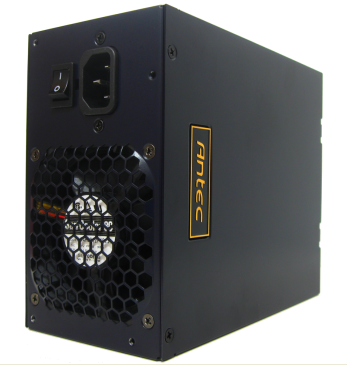
Original Link: https://www.anandtech.com/show/3992/1000w1200w-highend-psuroundup
1000W-1200W Roundup: Five High-End PSUs
by Martin Kaffei on December 9, 2010 1:20 PM EST1000W-1200W Roundup: Five High-End PSUs
Today we're looking at some of the most expensive ATX power supplies on the market. All of these PSUs deliver more than enough power for SLI and CrossFire systems, and the highest wattage units are capable of running tri-SLI with GTX 480. Even so, there are still plenty of differences between the offerings. We'll find out which handle overload situations the best, who has the highest efficiency, and which PSU provides the best voltage regulation. Based on all of the criteria, we'll try to separate the wheat from the tares and pick out the best choice overall; we might end up with a split decision, however, so let's start by meeting the contenders.
Our first candiate comes from OCZ and is one of the oldest 80Plus Gold power supplies on the market. The OCZ Z1000M is the 1000W model from their Z-series; it comes EuP-Ready (which means low power loss during standby mode) and is available for $205 online. In contrast to the Z1000, this model includes modular cables like most high-end power supplies, and you get an SLI-Ready certificate. A powerful single-rail +12V rated at 83A indicates that this PSU uses a DC-to-DC converter (like most other high-end PSUs these days), so the smaller rails are fed by +12V.
The next 1000W PSU comes from AeroCool with a lesser 80Plus Bronze certification. To compensate the "low" efficiency AeroCool catches our eyes with blue 140mm LED-fans, a lighted panel for cable management, and "Carbon Fiber" finishing. The AeroCool V12XT-1000 1000W is not available in the United States, but you can get it for €165 in Germany (about $230).
Cougar is a newcomer and the retail-brand of HEC, who has a long OEM history. Cougar is using HEC's best build options and robust cases for their power supplies. The Cougar GX G1050 1050W can be bought in Europe, with a few models also showing up in the USA. In Europe you've to pay €190 (a rather expensive $265) to get this beautiful PSU. Is it a good high efficiency option, with another 80Plus Gold certificate? We'll find out.
Besides the three 1000W PSUs, we also have two 1200W models for this roundup. The first is the Cooler Master Silent Pro Gold 1200W. Yet another 80Plus Gold PSU - notice a trend? - can it meet the specs and live up to its "silent" name? Most PSUs above 1000W need powerful cooling at high load, so any suggestion of silence seems like pie in the sky. Regardless of the noise levels, we'll test this Cooler Master to see how the single +12V rail rated at nearly 100A stands up to the competition. Pricing is only slighly higher than other 1000W PSUs, checking in at $210.
Our final entrant in today's roundup comes from Antec, a familiar name to most computer enthusiasts. Their latests creations is the Antec High Current Pro HCP-1200. Priced at $300 online, it's the most expensive PSU in our list and it once again boasts an 80Plus Gold certification. Unlike most of the other PSUs, the HPC-1200 has eight +12V rails, but it also uses DC-to-DC conversion and Japanese capacitors (almost a requirement to high 80Plus Gold). An unusual features is the 80mm fan for cooling, rather than the typical 120mm or 140mm fans we see elsewhere. Antec has created a new design with two PCBs to increase airflow and allow for optimal use of the 80mm fan. We'll see if this works well, or if it simply result in higher noise levels but similar temperatures and efficiency.
OCZ Z1000M Overview (1000W)
OCZ's Z-series Z850 and Z1000 are the oldest available 80Plus Gold PSUs for high-end PCs. They're also the only OCZ models with 80Plus Gold in OCZ's range of products. Are they able to keep up with the more modern PSUs? We'll see, but OCZ makes their package a bit more interesting with a generous supply of cable ties, two power supply cable (for different power grids), and a nicely written user's guide. In addition, the standard 5-year warranty isn't too shabby. The Z1000M that we will review today is SLI-ready, has active PFC, and as the "M" suffix indicates it includes modular cable management. The PSU case has a length of 16cm.
| Cables and Connectors | ||
| Fixed/Modular | Main | 24-pin 55cm |
| ATX12V/EPS12V | 4+4-pin 60cm / 8-pin 60cm | |
| PCIe | 6x 6/8-pin 60cm | |
| Peripheral | 3x SATA 50-80cm / 3x SATA 50-80cm / 3x SATA 60-90cm | |
| 3x Molex 55-85cm + Floppy 15cm | ||
There are two very long 8-pin connectors for the CPU, which is nice to see. In contrast to that the six 6/8-pin PCIe connectors are a common configuration for a 1000W PSU. We'd might like to see OCZ offer one more cable with Molex connectors, as there are only three on a single cable. All cables have a length of more than 50cm, and as usual the mainboard cables are fixed.
Globe Fan is the manufacturer of the large fan in the OCZ PSU. The model number is RL4Z B1352512H, a ball-bearing type with a maximum rotation of 1500RPM. This is a common choice Sirtec-manufactured PSUs.
Internally, you can see the typical Sirtec design with an 80Plus Gold configuration. We find the DC-to-DC converter, Infineon transistors with a low DS resistance, and a good looking EMI-filterung stage including a MOV. For safety functions OCZ uses a PS224 from Silicon Touch. The heatsinks seem to be small, but they should be enough for a strong cooled and very efficient power supply. Some outgoing cables on the left side are pinched by two cables ties, which isn't the best way of doing things but should work well enough.
OCZ Z1000M Regulation
| +3.3V regulation | |
| Load | Voltage |
| 10% | +2.73% |
| 20% | +2.12% |
| 50% | +1.21% |
| 80% | -0.61% |
| 100% | -1.82% |
| 110% | -2.42% |
| +5V regulation | |
| Load | Voltage |
| 10% | +2.40% |
| 20% | +2.40% |
| 50% | +1.40% |
| 80% | +0.40% |
| 100% | -0.40% |
| 110% | -0.80% |
| +12V regulation | |
| Load | Voltage |
| 10% | +1.83% |
| 20% | +1.75% |
| 50% | +1.42% |
| 80% | +0.92% |
| 100% | +0.33% |
| 110% | +0.08% |
The +12V rail is very stable and always above 12.00V. Only the +3.3V could use better regulation, as it shows a voltage drop of more than 5.15% during our test from 10% to 110% load. +5V starts sonewhat high and ends 0.80% under the optimal value.
Ripple and Noise
| +3.3V ripple quality | |
| Load | Ripple and noise |
| 10% | 14.80mV |
| 20% | 18.40mV |
| 50% | 20.90mV |
| 80% | 28.50mV |
| 100% | 33.20mV |
| 110% | 35.30mV |
| +5V ripple quality | |
| Load | Ripple and noise |
| 10% | 20.90mV |
| 20% | 23.50mV |
| 50% | 27.90mV |
| 80% | 34.40mV |
| 100% | 42.60mV |
| 110% | 46.80mV |
| +12V ripple quality | |
| Load | Ripple and noise |
| 10% | 46.80mV |
| 20% | 57.30mV |
| 50% | 74.80mV |
| 80% | 90.30mV |
| 100% | 101.60mV |
| 110% | 118.30mV |
OCZ has some small transients on +3.3V, while +12V shows a high ripple, but they are all still within specifications. While technically satisfactory, the results certainly aren't great for a very expensive PSU. 118mV on +12V and 47mV on +5V are both very close to the 120mV and/or 50mV limit.
OCZ Z1000M Noise
| Sound Pressure Level | |
| Load | dB(A) |
| 10% | 18 |
| 20% | 18 |
| 50% | 20 |
| 80% | 22 |
| 100% | 25 |
| 110% | 29 |
The OCZ isn't very noisy at low loads, and 29dBA at 110% overload is decent for a 1000W PSU. From 0-80% load, this PSU is nearly silent. It may not be the most silent PSU we have ever seen, but we have seen (and will see again) louder offerings, including several in this roundup.
Efficiency and PFC
| 230VAC, 50Hz | ||
| Load | Efficiency | PFC |
| 10% | 84% | 0.804 |
| 20% | 89% | 0.852 |
| 50% | 91% | 0.915 |
| 80% | 91% | 0.943 |
| 100% | 89% | 0.954 |
| 110% | 88% | 0.960 |
| 115VAC, 60Hz | ||
| Load | Efficiency | PFC |
| 10% | 83% | 0.938 |
| 20% | 88% | 0.943 |
| 50% | 90% | 0.980 |
| 80% | 89% | 0.986 |
| 100% | 87% | 0.991 |
| 110% | 86% | 0.993 |
OCZ barely squeaks by and meets the 80Plus Gold requirement (87% on 115VAC, or 88% on 230VAC), but it's not quite at the same 90%+ range as some of the other PSUs. The results at 10% load are also good if not great. Interesting to note is that our measurements are slightly lower than the 80Plus organization's results.
AeroCool V12XT 1000W Overview
AeroCool is the only candidate in this roundup with a high-end PSU that forgoes 80Plus Gold, but they have an interesting looking case. There are very few package contents: just one power cable and the modular cables. With 80Plus Bronze certification, an LED fan and LED female plugs, there ar no special technologies or features, but the carbon fiber exterior looks extraordinary. The housing is 18cm long
| Cables and Connectors | ||
| Fixed/Modular | Main | 24-pin 60cm |
| ATX12V/EPS12V | 8-pin 60cm + 4+4-pin 30cm | |
| PCIe | 2x 6/8-pin 50cm / 2x 6-pin 50cm / 1x 6/8-pin PCIe 60cm / 1x6-pin PCIe 60cm | |
| Peripheral | 4x SATA 50-95cm / 4x SATA 50-95cm | |
| 3x Molex 50-80cm / 3x Molex 50-80cm + Floppy 15cm | ||
The main cables as well as the two 60cm long PCIe connectors are fixed. All the cables are long enough, especially the ATX12V/EPS12V cable, but only eight SATA connectors may be a bit limiting if you plan on using many HDDs/SSDs/DVDs. On the other hand, the V12XT has twice as many Molex connectors as the OCZ.
This transparent 13.50cm fan is a DFS132512H (H stands for highRPM) from Young Lin Tech with a common sleeve bearing type. Like most other Young Lin fans this one has seven fan blades.
AeroCool is using an older HEC design with two transformers, a large main cap from Nippon Chemi-Con, and small heatsinks on the primary side. Again, there are big outgoing cables and all solid capacitors on the secondary side. This design has an interleaved Power Factor Preregulator with two parallel working magnetic cores, with a switcher and diodes to get less ripple current at high loads. Many insulators can be found on the cables and the sister PCB for cable management.
AeroCool V12XT Regulation
| +3.3V regulation | |
| Load | Voltage |
| 10% | +2.73% |
| 20% | +2.12% |
| 50% | +0.00% |
| 80% | -1.81% |
| 100% | -3.33% |
| 110% | -4.24% |
| +5V regulation | |
| Load | Voltage |
| 10% | +2.00% |
| 20% | +1.40% |
| 50% | -0.60% |
| 80% | -2.20% |
| 100% | -3.60% |
| 110% | -4.40% |
| +12V regulation | |
| Load | Voltage best/worst |
| 10% | +2.00% / +1.58% |
| 20% | +1.67% / +1.25% |
| 50% | +0.42% / -0.25% |
| 80% | +0.00% / -1.67% |
| 100% | -0.75% / -2.75% |
| 110% | -1.00% / -3.33% |
AeroCool has one of the worst regulations out of all the high-end PSUs we've tested. The DC-to-DC VRMs are very weak, so the voltage has huge drops on +3.3V and +5V. Even +12V (V4/V5/V6) could be more stable. Most PSUs with DC-to-DC have no problems with ATX conformable loads on +12V, but the voltage drops on this particular PSU make the overall quality suspect at best.
Ripple and Noise
| +3.3V ripple quality | |
| Load | Ripple and noise |
| 10% | 13.70mV |
| 20% | 15.40mV |
| 50% | 27.60mV |
| 80% | 52.80mV |
| 100% | 62.60mV |
| 110% | 71.90mV |
| +5V ripple quality | |
| Load | Ripple and noise |
| 10% | 15.60mV |
| 20% | 17.30mV |
| 50% | 28.00mV |
| 80% | 45.80mV |
| 100% | 56.30mV |
| 110% | 61.70mV |
| +12V ripple quality | |
| Load | Ripple and noise |
| 10% | 17.80mV |
| 20% | 21.00mV |
| 50% | 35.50mV |
| 80% | 88.30mV |
| 100% | 144.10mV |
| 110% | 163.50mV |
Did we accuse OCZ of having high ripple on +12V? Okay, AeroCool is definetly worse! All the rails have ripple and noise problems; at full load, every rail is out of specification, and it only gets worse at overload. 72 mV on +3,3V is certainly "impressive"...impressively bad. It's probably for the best that this unit isn't for sale in the US, because we definitely wouldn't recommend it.
AeroCool V12XT Noise
| Sound Pressure Level | |
| Load | dB(A) |
| 10% | 20 |
| 20% | 23 |
| 50% | 25 |
| 80% | 30 |
| 100% | 32 |
| 110% | 37 |
AeroCool is audible at all loads, and the fan always spins at 600RPM or more. It hits 30dBA starting at 80% load and hits a rather annoying 37dBA at overload - with some noise from the electronics thrown in for good measure.
Efficiency and PFC
| 230VAC, 50Hz | ||
| Load | Efficiency | PFC |
| 10% | 71% | 0.883 |
| 20% | 86% | 0.945 |
| 50% | 88% | 0.973 |
| 80% | 86% | 0.982 |
| 100% | 84% | 0.987 |
| 110% | 83% | 0.988 |
| 115VAC, 60Hz | ||
| Load | Efficiency | PFC |
| 10% | 70% | 0.987 |
| 20% | 85% | 0.991 |
| 50% | 86% | 0.993 |
| 80% | 85% | 0.994 |
| 100% | 84% | 0.996 |
| 110% | 81% | 0.998 |
While the power factor correction is very high, the efficiency is rather poor below 20% load. The performance is still enough to get 80Plus Bronze certification, but if you're spending this much on a PSU we would expect better. We don't think most of our readers would be particularly happy with this power supply, as the results are disappointing at best.
Cougar GX G1050
Cougar is a retail brand from HEC, and they sell some cases as well as many PSUs in EMEA. To export their products to the USA they started a marketing campaign a few months ago, which is why various tech sites have seen samples of late. AnandTech received their newest 80Plus Gold PSU from the GX-series (G for Gold). This series has PSUs rated at 600, 700, 800, 900 and 1050 watts; our test unit is the highest rated G1050 model. Cougar has two designs, one with a single transformer and two transistors, the other with two transformers (one switcher each) and an interleaved PFC; we will be looking at the latter.
In the GX G1050 box we find some mounting screws, cable ties, a power cord, a manual, and the modular connection cables. Besides the high efficiency, their robust case and special cable sleeving are the most interesting features. Moreoever Cougar told us that ripple and noise is low because of the CLC filtering; we'll test that claim shortly. The PSU case has a length of 18cm.
| Cables and Connectors | ||
| Fixed/Modular | Main | 24-pin 60cm |
| ATX12V/EPS12V | 8-pin 60cm + 4+4-pin 30cm + 4-pin 30cm | |
| PCIe | 6x 6/8-pin 50cm | |
| Peripheral | 4x SATA 50-95cm + 1x Molex 15cm / 4x SATA 50-95cm + 1x Molex 15cm / 4x SATA 60-110cm | |
| 3x Molex 50-95cm + Floppy adapter 15cm | ||
Two peripheral cables have SATA and Molex connectors; overall Cougar offers 12x SATA and 5x Molex. There is a very long cable with three different types of CPU connectors. This is good for just about any kind of mainboard, but three separate cables would be better. Most readers don't need more than one 4+4-pin connector and want to disconnect the other cables.
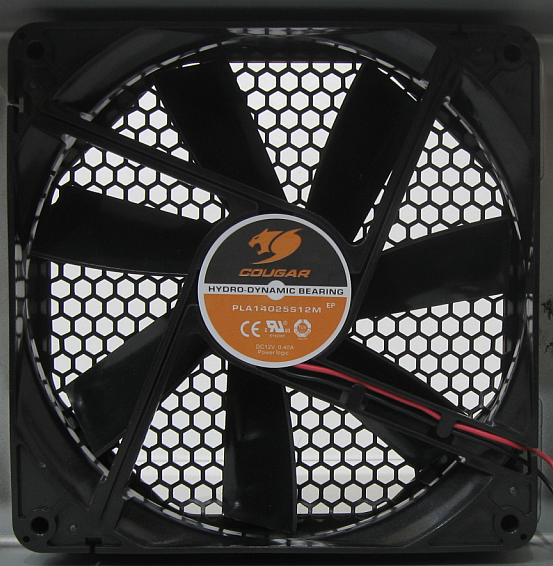
The GX fan has seven thin fan blades and comes from Power Logic, with the product number PLA14025S12M. It's a 140mm fan with a fluid dynamic bearing to provide increased longevity.
We have dismounted one part from the heatink on the secondary side to show more of the circuit. This Cougar design has DC-to-DC, synchronous rectifying, and more components than the smaller design used for the GX 600W. The main caps are from Japan while the other ones come from Teapo, a standard choice for HEC. There are many similarities to the AeroCool unit, largely because of the same EMI- and output-filtering. The rectifier bridge from Diodes Incorporated has its own heatsink and the wire cross-section of most cables is big.
Cougar GX G1050 Regulation
| +3.3V regulation | |
| Load | Voltage |
| 10% | +3.03% |
| 20% | +2.42% |
| 50% | +1.21% |
| 80% | -0.30% |
| 100% | -0.30% |
| 110% | -1.82% |
| +5V regulation | |
| Load | Voltage |
| 10% | +2.20% |
| 20% | +1.60% |
| 50% | +0.20% |
| 80% | -1.00% |
| 100% | -2.00% |
| 110% | -2.60% |
| +12V regulation | |
| Load | Voltage best/worst |
| 10% | +2.08% / +1.83% |
| 20% | +1.83% / +1.58% |
| 50% | +1.17% / +0.67% |
| 80% | +0.42% / -0.25% |
| 100% | -0.17% / -0.83% |
| 110% | -0.42% / -1.50% |
This power supply is better than the AeroCool V12XT, and not just because of the 80Plus Gold certification. As you can see the voltage drop is lower and all the rails are clearly within specifications. The +3.3V starts high at 10% load but 3% is still not a problem.
Ripple and Noise
| +3.3V ripple quality | |
| Load | Ripple and noise |
| 10% | 9.50mV |
| 20% | 10.40mV |
| 50% | 15.10mV |
| 80% | 25.40mV |
| 100% | 30.10mV |
| 110% | 39.70mV |
| +5V ripple quality | |
| Load | Ripple and noise |
| 10% | 14.90mV |
| 20% | 15.00mV |
| 50% | 28.40mV |
| 80% | 39.70mV |
| 100% | 50.70mV |
| 110% | 55.20mV |
| +12V ripple quality | |
| Load | Ripple and noise |
| 10% | 18.40mV |
| 20% | 28.40mV |
| 50% | 29.20mV |
| 80% | 44.30mV |
| 100% | 58.30mV |
| 110% | 69.50mV |
Cougar has some problems with high ripple on +3.3V and +5V at maximum load, but +12V never reached more than about half of the maximum allowed 120mV. While the results could be better, other brands have more problems here. The most important result is the +12V rail, and it performs well enough.
Cougar GX G1050 Noise
| Sound Pressure Level | |
| Load | dB(A) |
| 10% | 18 |
| 20% | 18 |
| 50% | 19 |
| 80% | 23 |
| 100% | 30 |
| 110% | 36 |
The Cougar is as silent as the OCZ at low loads, but it's louder at 100% and 110%. However, the GX series is still quieter than older designs with common Young Lin fans. It is nice to see less than 20dBA beneath 50% load.
Efficiency and PFC
| 230VAC, 50Hz | ||
| Load | Efficiency | PFC |
| 10% | 75% | 0.886 |
| 20% | 90% | 0.934 |
| 50% | 91% | 0.974 |
| 80% | 90% | 0.985 |
| 100% | 88% | 0.988 |
| 110% | 87% | 0.995 |
| 115VAC, 60Hz | ||
| Load | Efficiency | PFC |
| 10% | 73% | 0.979 |
| 20% | 88% | 0.978 |
| 50% | 90% | 0.993 |
| 80% | 88% | 0.995 |
| 100% | 86% | 0.996 |
| 110% | 84% | 0.996 |
With 89.79 % Cougar doesn't quite reach 80Plus Gold - unless you round up. Overall it does okay, and PFC is very high with both input voltages. The only real point of criticism is the low efficiency at 10% load (about 105W load); we'd recommend running high-end setups that idle at around 200W or more to get optimal efficiency from this PSU.
Cooler Master Silent Pro Gold 1200W
The 16cm long Silent Pro Gold is Cooler Master's latest creation. The package comes with flat modular cables with gold colored connectors, a manual, some screws, and a power cord. Cooler Master told us that there are some special technical features like the transformer core mounted to the heatsink. They have reduced some power loss from terminal pads because many components have direct contacts. Cooler Master offers a 5-year warranty.
| Cables and Connectors | ||
| Fixed/Modular | Main | 24-pin 50cm |
| ATX12V/EPS12V | 4+4-pin 60cm / 4+4-pin 60cm | |
| PCIe | 4x 6/8-pin 60cm + 6-pin 10cm | |
| Peripheral | 3x SATA 50-70cm / 3x SATA 50-70cm / 3x SATA 50-70cm | |
| 2x Molex 50-60cm /2x 50-60cm + Floppy adapter 15cm | ||
The two 8-pin CPU connectors and eight PCIe connectors are satisfying. However, the peripheral cables are very short and there are only four Molex connectors for fans and other peripherals. This is not the best solutions for large cases, but it's good enough for triple-SLI and quad-CrossFire setups.
The 135mm fan from Young Lin, model number DFS132512H, is the same one like in the AeroCool V12XT--not very silent nor professional. It's a typical sleeve bearing type spinning at up to 1800RPM with eleven fan blades.
On the right side you can see both DC-to-DC VRMs. This PSU has two main caps from Nippon Chemi-Con, a very small transformer, and a clean soldered cable management PCB. The L-shaped heatsinks should help to increase airflow. Cooler Master has no real single rail for +12V and OCP to protect their multi rail design. The active PFC circuit allows Cooler Master to sell and use this power supply in countries with 90-264VAC input voltage. The placement of parts near the power inlet seems to be very chaotic.
Cooler Master Silent Pro Gold 1200W Regulation
| +3.3V regulation | |
| Load | Voltage |
| 10% | +2.72% |
| 20% | +2.42% |
| 50% | +1.21% |
| 80% | +-0.00% |
| 100% | -0.61% |
| 110% | -0.91% |
| +5V regulation | |
| Load | Voltage |
| 10% | +0.60% |
| 20% | +0.40% |
| 50% | -0.40% |
| 80% | -1.20% |
| 100% | -1.80% |
| 110% | -2.00% |
| +12V regulation | |
| Load | Voltage |
| 10% | +3.08% |
| 20% | +2.83% |
| 50% | +2.42% |
| 80% | +2.08% |
| 100% | +1.75% |
| 110% | +1.25% |
The +12V rail is always 1-3% over the optimal value, while +5V drops to -2%; that's still fine and better than many other PSUs. +3.3V shows a larger drop but starts very high, so all rails are easily within specs.
Ripple and Noise
| +3.3V ripple quality | |
| Load | Ripple and noise |
| 10% | 10.10mV |
| 20% | 12.40mV |
| 50% | 19.50mV |
| 80% | 24.30mV |
| 100% | 28.40mV |
| 110% | 28.60mV |
| +5V ripple quality | |
| Load | Ripple and noise |
| 10% | 20.50mV |
| 20% | 20.50mV |
| 50% | 34.90mV |
| 80% | 48.50mV |
| 100% | 49.00mV |
| 110% | 51.30mV |
| +12V ripple quality | |
| Load | Ripple and noise |
| 10% | 22.10mV |
| 20% | 30.00mV |
| 50% | 62.30mV |
| 80% | 80.10mV |
| 100% | 85.80mV |
| 110% | 94.80mV |
+5V is above the specification at 110% overload, similar to the measurements from Cougar. With up to 100mV ripple and noise +12V has worse results than the Cougar GX series, but lower ripple on +3.3V. Which of these two is better? Let's look at the noise results before we try to decide.
Cooler Master Silent Pro Gold 1200W Noise
| Sound Pressure Level | |
| Load | dB(A) |
| 10% | 22 |
| 20% | 22 |
| 50% | 24 |
| 80% | 30 |
| 100% | 37 |
| 110% | 45 |
"Silent" Pro? That may be the most unsuitable name for a PSU like this. At high load the Cooler Master is as loud as the old PC Power and Cooling Turbo Cool 1000W. Even at low load Cooler Master is no match for the other PSUs in this roundup. 30 dBA at 80% load is far too much for a "silent" PSU; they really need a new brand name for their higher wattage PSUs. It's no secret that such power supplies need more cooling than smaller units, and no one expects silence from a 1200W PSU.
Efficiency and PFC
| 230VAC, 50Hz | ||
| Load | Efficiency | PFC |
| 10% | 83% | 0.840 |
| 20% | 90% | 0.877 |
| 50% | 91% | 0.930 |
| 80% | 91% | 0.952 |
| 100% | 89% | 0.958 |
| 110% | 89% | 0.962 |
| 115VAC, 60Hz | ||
| Load | Efficiency | PFC |
| 10% | 82% | 0.941 |
| 20% | 88% | 0.949 |
| 50% | 90% | 0.976 |
| 80% | 88% | 0.983 |
| 100% | 87% | 0.985 |
| 110% | 86% | 0.986 |
While the other results are somewhat disappointing, Cooler Master shows a high efficieny at 230VAC. Starting from 20% the efficiency is above 89%. As usual, 115VAC is slightly lower, particularly from 80% to 110% load. The results at 10% are also decent, coming in above 80% in both our tests.
To answer our question from the last page, then, the Silent Pro Gold 1200W does end up with better results than the Cougar GX, at least in the efficiency department. Let's see how our final PSU compares before coming to a conclusion.
Antec HCP-1200 (High Current Pro 1200W) Overview
Our HCP (High Current Pro) sample arrived without any packaging, as it was one of the first samples and the final package contents weren't yet finalized. The shipping product includes the standard mounting screws and manual, plus the modular cables. Unlike the other PSUs in this roundup, Antec is using an 80mm fan from Sanyo Denki for cooling, reminiscent of old PC Power and Cooling designs. The case is 18cm long, typical for high wattage PSUs.
| Cables and Connectors | ||
| Fixed/Modular | Main | 24-pin 65cm |
| ATX12V/EPS12V | 4+4-pin 65cm / 8-pin 65cm | |
| PCIe | 4x 6/8-pin 55cm + 4x 6/8-pin 15cm | |
| Peripheral | 3x SATA 55-85cm / 3x SATA 55-85cm / 3x SATA 55-85cm / 3x SATA 55-85cm | |
| 3x Molex 55-85cm/ 3x Molex 55-85cm / 3x Molex 55-85cm + Floppy 15cm | ||
Antec offers many SATA connectors but you can't conect all of them if you want to use all the Molex cables as well. The reason is there aren't enough sockets on the modular cabling system, so you're limited to choosing which cables you will use. Like Cooler Master Antec has eight PCIe connectors but they're longer and all have 6/8-pin heads. The two 8-pin connectors for CPUs are relatively common for 1200W PSUs, again just like the Cooler Master.
The 80mm fan is a ball bearing type with the product number 9AH0812P4G131 with a lifespan of 120,000hrs @ 40°C and up to 4500RPM. That sounds high, but as we will see later Antec manages to turn in some impressive results.
Antec has two PCBs with four (!) main caps from Rubycon. On the secondary side we can find more Rubycon caps and some all solid Nippon Chemi-Con caps as well. The transformer looks very small like the one from Cooler Master and there are very modern transistors with a low drain-source resistance. The protecion IC can be found on the second picture on the right sister PCB. The soldering quality is absolutely flawless.
Antec HCP-1200 Regulation
| +3.3V regulation | |
| Load | Voltage |
| 10% | +0.91% |
| 20% | +0.00% |
| 50% | -0.91% |
| 80% | -1.52% |
| 100% | -2.72% |
| 110% | -3.64% |
| +5V regulation | |
| Load | Voltage |
| 10% | +0.00% |
| 20% | -0.20% |
| 50% | -0.60% |
| 80% | -1.20% |
| 100% | -1.60% |
| 110% | -2.00% |
| +12V regulation | |
| Load | best/worst |
| 10% | +1.42% / +1.08% |
| 20% | +1.50% / +1.25% |
| 50% | +1.50% / +1.00% |
| 80% | +1.00% / +0.58% |
| 100% | +0.58% / +0.25% |
| 110% | +0.33% / +0.00% |
Wow! No, seriously, check out the 12V regulation. It starts just over 1% high and at 110% overload it still delivers the ideal voltage. +5V starts at the ideal and drops just 2%, which is also good. The 3.3V rail shows a more significant drop, but it's not as critical on modern systems and it's still within spec.
Ripple and Noise
| +3.3V ripple quality | |
| Load | Ripple and noise |
| 10% | 8.80mV |
| 20% | 9.20mV |
| 50% | 11.50mV |
| 80% | 16.30mV |
| 100% | 19.70mV |
| 110% | 18.70mV |
| +5V ripple quality | |
| Load | Ripple and noise |
| 10% | 13.20mV |
| 20% | 15.10mV |
| 50% | 23.70mV |
| 80% | 29.20mV |
| 100% | 31.50mV |
| 110% | 35.50mV |
| +12V ripple quality | |
| Load | Ripple and noise |
| 10% | 9.90mV |
| 20% | 9.90mV |
| 50% | 13.30mV |
| 80% | 18.20mV |
| 100% | 19.70mV |
| 110% | 19.90mV |
+5V shows some undershoots, which is why we see the higher results on that rail. The other rails have hardly any ripple or noise. Particularly impressive is the +12V result, with ripple always below 20mV. The oscilliscope showed very clean results with no transients.
Antec HCP-1200 Noise
| Sound Pressure Level | |
| Load | dB(A) |
| 10% | 18 |
| 20% | 19 |
| 50% | 19 |
| 80% | 24 |
| 100% | 28 |
| 110% | 34 |
Antec is a little bit louder than OCZ at maximum load, but 34dBA is great for an 80mm fan, and it's also very good for a 1200W PSU. The HCP-1200 is virtually silent at anything below 50% load, though it's doubtful the rest of your system will fare as well if you're pulling 600W or more. In this case, Antec delivers better noise than several other competitors despite the use of a higher RPM 80mm fan - a testament to the quality of components and the engineering.
Efficiency and PFC
| 230VAC, 50Hz | ||
| Load | Efficiency | PFC |
| 10% | 86% | 0.885 |
| 20% | 89% | 0.975 |
| 50% | 91% | 0.989 |
| 80% | 91% | 0.989 |
| 100% | 89% | 0.995 |
| 110% | 88% | 0.995 |
| 115VAC, 60Hz | ||
| Load | Efficiency | PFC |
| 10% | 85% | 0.981 |
| 20% | 89% | 0.990 |
| 50% | 90% | 0.999 |
| 80% | 88% | 0.997 |
| 100% | 88% | 0.996 |
| 110% | 87% | 0.996 |
Delivering 85/86% efficiency even at a low 10% load is a great place to start, and it only goes up from there. Nevertheless, we did measure slightly less than ECOS Gold Certification at 50% load; the exact figure was 89.62%, but we rounded up to 90%. That could just be a slight measuring tolerance, but even so Antec could be more efficient. It's still a great PSU overall, but with the cost we wanted to see just a little bit more separation from the competition.
Conclusion
OCZ Z1000M - High +12V ripple, only three Molex connectors
As previously mentioned the Z-Series is an "old" 80Plus Gold PSU. The efficiency is still high at up to 91% while testing with 230VAC and 50% load. On 115VAC OCZ is right at the 87% requirement, so the 80Plus Gold certificate is appropriate. In addition 83% efficiency at low load is nice to see. Of course, the power factor could be higher but the more important noise level is what makes this PSU interesting for buyers. 18dBA is a good starting point and even at 110% OCZ is below 30dBA.
Points we have to criticize are the connector configuration with only 3x Molex on one cable and the high ripple and noise results on +5V and +12V. With ~47mV and ~118mV, both are close to the ATX limit, especially +12V. While this voltage quality is no glorious result the voltage regulation is tight overall.
OCZ gives users quite a few cable ties, two 8-pin connectors for the CPU (one with 4+4-pin), and six 6/8-pin PCIe connectors; nothing out of the ordinary for a 1000W PSU. In summary, the OCZ Z-Series 1000W is a reasonable power supply, especially if the price is right and if you're okay with the peripheral cables arrangement. Currently selling at Buy.com for $205, it's not a bad PSU but the high ripple isn't in the same league as other high-end PSUs.
AeroCool V12XT 1000W - Highest ripple and noise, worst voltage regulation
The overall quality of this V12XT model is perhaps the worst we've seen from an "upper-class" PSU. While +3.3V and +5V drop below -4% and +12V has an average regulation/voltage drop, every rail has problems with ripple and noise. +3.3V reached about 72mV, so 22mV or 44% over specification, and +12V is way out of spec with more than 163mV - even cheap PSUs have better results than this! The efficiency is okay for an 80Plus Bronze PSU with up to 88% at 230VAC, but the ~70% result at 10% load is sub-standard.
HEC is the ODM behind AeroCool and there are many similarities to the GX series from Cougar, but there are still many differences in the design and AeroCool has the older layout. There is one big main capacitor from Nippon Chemi-Con, two transformers and DC-to-DC on the secondary side.
With eight SATA connectors on two cables and not much in the way of package contents, it is hardly surprising that the price is relatively low. There are more than enough connectors to build a PC with several HDDs/SSDs, but for the price it needs to be better.
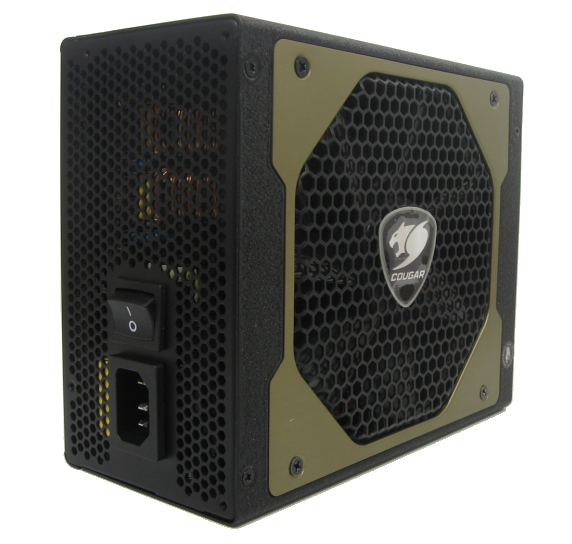
Cougar GX G1050 1050W - Robust and interesting case design, average efficiency
Cougar has a lot of experience in metal processing and is shows with their good looking GX series case. Unfortunately, a nice case isn't enough to make a good power supply. Ripple and noise is high on +5V, even if this should not be a real problem for modern PCs. +12V reached only about half of specification which is adequate and +3.3V has some buffers too.
Cougar has the same EMI filtering as AeroCool, but with an actual switcher and two main caps in the interleaved PF-preregulator. In the secondary circuit they are still using Taiwanese caps instead of Japanese ones. However, the design has output reserves like a Revolution85+ and the same robust look (with some Enermax-like cable ties in the delivery contents). Apart from that the efficiency is extremely low at 10% load. The G1050 also manages near silence at low loads.
A nice cable sleeving and a very long cable with CPU connectors are uncommon features. Certainly other manufacturers provide good sleeving, but this one looks special. The six 6/8-pin PCIe are an usual configuration but enough for triple SLI setups.
Cooler Master Silent Pro Gold 1200W - Short cables, not particularly silent
The Silent Pro series has flat cables like Corsair but very short cables and just four HDD connectors. With just 70cm for the SATA cables and up to 60cm for Molex, Cooler Master forfeits a chance to compensate for the high ripple and noise results. As expected this PSU has eight PCIe connectors for triple-SLI or quad-CrossFire.
We measured nearly 100mV ripple on the +12V rails and a little bit too much on +5V, giving us a sense of déjà vu. Cooler Master has the same disadvantages as the OCZ, but in this case there is also the noisy fan. Starting at 20dBA and ramping up to the highest levels of today's five tested power supplies, the Silent Pro is definitely a misnomer. At high load it is as loud as the old PC Power and Cooling Turbo Cool and much louder thant the previously tested Silent Pro 1000W. The effect of the L-shapped heatsinks is vanishingly low and they need more than moderate fan speeds for cooling.
Other aspects aren't quite so bad, though. Most caps are from Japan, particularly the ones on the secondary side. Moreover Cooler Master has DC-to-DC and a very good soldering quality. The filtering behind the AC inlet does look chaotic, however. All in all the Silent Pro Gold can't live up to its name because it is simply impossible to use the same fan control as the smaller models to reach acceptable temperatures. Cooler Master should use another name for their high wattage PSUs - or come up with a better design.
Antec High Current Pro 1200W - Best quality, extra modular cables, high price
Like Cooler Master Antec offers 8x PCIe connectors, but they provide longer cables and all the connectors have 6/8 pins. The HCP-1200 has many peripheral connectors, more than you can actually use in fact, but that provides users some flexibility in determining how to set up their systems. The 65cm 24-pin and CPU cables are nice and long as well, making this a good PSU for larger cases
Delta Electronics is the ODM behind this PSU. Their design has two main PCBs with a heavy duty 80mm fan providing cooling. Interesting to note is that the smaller fan stays below 19dBA through 50% load. Antec uses Japanese capacitors only (Nippon Chemi-Con and Rubycon) and four large main caps. This is on of the highest quality builds we've seen!
Our test Antec PSU didn't quite make it to 80Plus Gold efficiency levels on 115VAC, and +3.3V could be regulated better. Nevertheless, the HCP-1200 is impressive as it delivers excellent (i.e. low) ripple and noise results. +12V has a maximum ripple of 20mV, and +3.3V is even better. A generally quiet fan combined with clean voltages makes the Antec High Current Pro a good choice for enthusiasts. Our only word of caution is that you can only use five cables for peripherals, leaving you with a couple extras; you'll have to decide if that's a problem.
Closing remarks

We tested five high-end PSUs ranging from 1000W to 1200W, and we encountered a few common problems. A new topology and high wattages require manufacturers to put more effort into quality control, but above all they need to take more time. At the moment many manufactures want to reach 80Plus Gold faster than the competition, which is why we're seeing problems with the designs (e.g. high ripple and noise). Because they're in such a rush, they don't have time to correct their mistakes, so we end up with less desirable high-end PSUs. There's definitely room for improvement.
The Antec High Current Pro 1200W is one of the PSUs that delivers better results in all the areas that matter, and it's easily the best product in this roundup. It's not perfect, but in the end we have to praise the stellar voltage quality. We're giving them a Silver rather than Gold for a couple reasons; first and foremost, the price is quite high at $300 online. The second reason is a bit cheeky: our test sample managed to reach only 89.62% efficiency during 50% load, coming in just shy of an official 80Plus Gold level; likewise, we feel the HCP-1200 falls just shy of being the best in every area so a Silver Editors' Choice is fitting. There's also still that question of whether you need a 1200W PSU; for 99.9% of users, the answer is no, but there are enthusiasts out there running three or four GPUs with four or more hard drives, so if you fall into that category this is the best high-wattage PSU we've tested so far.

